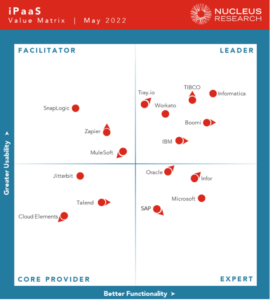This interview discusses the 2022 version of the Value Matrix. Boomi is proud to once again be a leader in the 2024 Nucleus Research iPaaS Technology Value Matrix.
Nucleus Research got right to the point in the introduction of its iPaaS Technology Value Matrix 2022. The analyst firm noted that the continuing wave of large-scale modernization initiatives requires an even greater focus on efficient integrations and workflow automation.
The bottom line? The integration platform as a service (iPaaS) market has rapidly grown and is poised for further expansion.

“Over the past year, companies have continued to deploy low-code environments to simplify integration processes, reduce costs, enable business users, and redeploy developers to more advanced areas and projects,” Nucleus Research wrote.
Nucleus Research’s Senior Analyst Alexander H. Wurm, who authored the report that accompanies the Value Matrix, said it’s an exciting time to study technologies around analytics, databases, data warehousing, and integration. He noted that these systems are all transforming the way businesses operate at a remarkable speed.
“I come from a data science background,” Wurm said. “The first thing you should know about any data scientist is they spend more than half of their time working on data prep, ensuring data quality, and troubleshooting. Bad data can be so harmful to your business. So, integration is really at the heart of everything when it comes to accurate, high-quality data.”
We recently chatted with Wurm about the Value Matrix, trends he sees in integration and automation, and the one factor that drives the most buying decisions today. Here are highlights from our conversation.
How do you describe Nucleus Research’s approach to looking at vendors and markets?
Wurm: The primary way we evaluate organizations is in terms of the functionality of their solutions and usability. The functionality determines what sort of company will be interested in the solution. But we believe usability is one of the greatest factors overlooked by evaluation criteria. Unless you have a solution that your employees will take advantage of, it’s not really useful. The leaders in the market can balance innovative functionality and usability. That’s especially the case in iPaaS as we see that shift to low code and business level employees using the solution rather than just technical IT staff.
What will people learn from the Value Matrix?
Wurm: You’re getting a short list of vendors to consider. There’s no bad quadrant in the Value Matrix. If you’re a smaller company with a limited IT team, you might look at the Facilitators that are highly usable with less complex tools. If you have less budget, you might look at Core Providers to give you capabilities at a lower cost. And if you have those expensive IT teams and the resources to support a complex tool, you might look at an Expert.
The Leaders are the vendors we think do exceptionally well in pairing extensive functionality with a highly usable product. For Boomi, I see it as a leader in the market that’s definitely a strong tool for IT staff and business analysts.
You write, “The value of an integration platform has never been greater.” Why?
Wurm: This is an interesting time because many companies are growing very fast, especially in their data operations. On-prem infrastructure just doesn’t work with that. You’re seeing companies having to decide if they should expand their data centers, which comes with additional costs and updating their hardware. That’s incentivizing the modernization we’re seeing in this shift to the cloud. The interesting thing from an iPaaS perspective is because there’s so much more data and many more solutions, the ability to integrate and track that data is becoming a center stage problem. People need to know where their data is and how reliable it is. That’s the focus for tech teams at the companies I advise.
Was there a lightbulb moment when you saw widespread recognition of the need for modern integration?
Wurm: I wouldn’t say there was any one moment. We’ve seen data utilization and cloud modernization scaling for quite some time. Then the pandemic sparked a lot of modernization initiatives that led to a proliferation of data. What 2020 did was emphasize the employee element of technology and especially of data-driven decision-making. You have to equip your workers with the tools that allow them to utilize data, or you’ll never get a higher level of decision-making.
Also, money was easy for quite some time. Now there’s a changing fiscal environment that’s impacting operations. People are looking for tools that can work with what you already have.
Can you explain more about how iPaaS factors into discussions about tighter budgets?
Wurm: By far, the number one thing we’ve seen in just the number of deals being closed lately is cost. Nucleus’ perspective is we evaluate ROI and value in three ways. The first is reducing costs. The other factors are improving productivity and increasing revenue. But that cost element is driving adoption, and it has certainly escalated as companies have become more constrained with their budgets. Sure, you can improve performance and productivity. But everyone is focused on reducing costs.
Where does low code factor into the equation?
The role of IT-centric solutions is relatively the same because they’re for technical people who understand those tools. But we’re also seeing growth in business-led initiatives to embrace data. That’s led to this low-code paradigm where everyone is trying to equip the business user with these tools even if they don’t have a technical skill set. The reality also is that companies don’t have the money to bring on a lot of technical talent. And those technical skill sets are in very high demand as data proliferates. So you’ve got to work with what you have. That’s led to the emphasis on low code. It’s happening on the back of keeping costs in check.
If people are unfamiliar with the iPaaS market, evaluating vendors can be challenging. What’s your best advice?
Wurm: My position is always to think about the people who will be doing the groundwork. Who will be using those tools on a day-to-day basis? Getting a highly functional tool may be great, but if you don’t have the employees with the technical toolset to support it, you’re not going to have success. So really evaluate the people behind the technology and how they actually are going to use it. If they’re unable to use it well, you should look at a different product.
Why do you think the idea of connectivity will remain a focus?
Wurm: Today, companies have tons of data used in every facet of decision-making. Connectivity comes into play because people need to ensure that the data they’re using is good, accurate, and available across systems. We’ve seen a push into data lineage and data tracking. And we’ve seen data cataloging to give more granularity into how that data is being used and connected.
The next step is having a better understanding of your data. iPaaS providers are key to that because they’re the ones that deal with all of your data. You’re not going to have one point solution tell you the landscape of all the data you’re using. The only ones equipped to do that are integration providers.
Download a complimentary copy of the Nucleus Research iPaaS Technology Value Matrix 2022 to learn more about marketplace trends and how the firm evaluates leading vendors.

 English
English 日本語
日本語